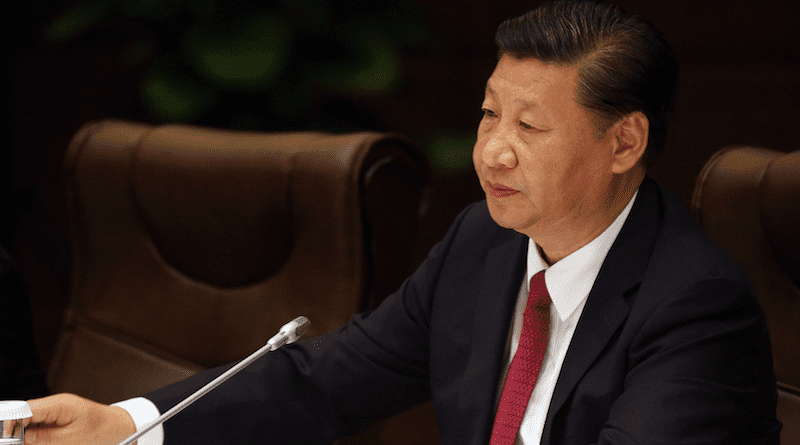Xi Jinping’s Grand Strategy: Navigating China’s Path On Global Stage – OpEd
In the realm of international relations, the concept of “grand strategy” plays a pivotal role in shaping a nation’s vision, goals, and actions. Among the world leaders who have displayed a keen grasp of grand strategy, Chinese President Xi Jinping stands out. Since coming to power in 2012, Xi has laid out a comprehensive blueprint to elevate China’s position on the global stage. His grand strategy encompasses a mix of domestic reforms, regional partnerships, and assertive foreign policies. Analyzing the contours of Xi Jinping’s grand strategy provides valuable insights into the evolving dynamics of China’s rise and its implications for the world.
At the core of Xi Jinping’s grand strategy is the idea of the “Chinese Dream,” which aims to achieve the “great rejuvenation” of the Chinese nation. This overarching vision encompasses both economic prosperity and national unity. Economically, Xi seeks to transform China into a modern, innovative, and technologically advanced powerhouse. Domestically, he emphasizes the rejuvenation of China’s cultural heritage, promoting the Chinese values and traditions while embracing modernity. Through this comprehensive approach, Xi seeks to bolster China’s soft power and foster a sense of national pride and unity.
One of the key pillars of Xi’s grand strategy is the Belt and Road Initiative (BRI). Launched in 2013, the BRI is a vast infrastructure and investment project that spans across Asia, Europe, Africa, and beyond. It aims to enhance regional connectivity, facilitate trade, and promote economic cooperation. By investing in critical infrastructure projects, China not only opens new markets for its goods but also cements its influence in participating countries. Critics argue that the BRI may lead to debt traps and erode the sovereignty of partner nations, but proponents see it as a means to achieve mutual economic growth and build long-lasting partnerships.
Additionally, Xi Jinping has focused on strengthening China’s military capabilities, signaling a shift towards a more assertive foreign policy. The modernization of the People’s Liberation Army (PLA) has been a priority under Xi’s leadership. From the creation of a new Southern Theater Command to advancements in cyber and space warfare, China has shown its determination to defend its territorial claims and secure its interests. While this has raised concerns among neighboring countries and the international community, it reflects China’s growing willingness to protect its core interests and project its influence beyond its borders.
In terms of regional partnerships, Xi Jinping has been proactive in nurturing alliances and enhancing China’s role in multilateral institutions. The establishment of the Asian Infrastructure Investment Bank (AIIB) in 2014 was a clear indication of China’s intent to play a more prominent role in shaping the rules of the global economic order. Through AIIB and other diplomatic efforts, China seeks to counterbalance the influence of traditional Western-dominated institutions like the World Bank and the International Monetary Fund. This approach enables China to expand its geopolitical clout and foster cooperation on its own terms.
Furthermore, Xi’s grand strategy also emphasizes the importance of technological prowess. China has heavily invested in emerging technologies like artificial intelligence, 5G, and quantum computing. By becoming a global leader in these fields, China aims to achieve technological self-sufficiency and reduce its reliance on foreign technology. This drive for technological dominance aligns with Xi’s vision of positioning China as an innovative and advanced nation, capable of shaping the course of the Fourth Industrial Revolution.
However, it is crucial to acknowledge that Xi Jinping’s grand strategy faces its share of challenges and criticisms. Internally, there have been concerns about the concentration of power within the Chinese Communist Party and the potential erosion of political reforms. Human rights issues, including the treatment of ethnic minorities in Xinjiang and restrictions on civil liberties, have also drawn international scrutiny.
Externally, China’s assertive behavior in territorial disputes, such as those in the South China Sea, has raised tensions with neighboring countries and triggered concerns about regional stability. Moreover, the Belt and Road Initiative has faced criticism over its lack of transparency and environmental impact, adding to skepticism about China’s intentions.
In conclusion, Xi Jinping’s grand strategy for China encapsulates a multifaceted approach to elevate the nation’s global standing. From the ambitious Belt and Road Initiative to the drive for technological dominance, Xi’s vision represents a significant shift in China’s role on the international stage. While it has garnered praise for its economic and infrastructural contributions to participating nations, it has also raised concerns over China’s assertive foreign policies and human rights record. As China continues to navigate its path as a rising global power, the world will closely observe how Xi’s grand strategy evolves and its implications for international relations in the years to come

